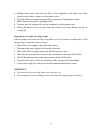
21
Water distribution tube cleaning
When you find the ice cubes are incompletely formed or the output is low, the water
distribution tube may be blocked. Turn off the power button, rotate the water distribution
tube, locate the holes in the distribution tube and use a pointed object such as a toothpick
to dredge the holes. Then rotate the water distribution tube back to its original position. If
the tube is badly blocked, clean it as follows:
1. Shut off the water supply
2. Disconnect the water hose from the distribution tube.
3. Lift the right side up, then remove the distribution tube.
4. With a brush, clean the tube with a dilute solution of warm water and a mild detergent
such as dishwashing liquid. After removing the dirt and lint from the surface, rinse the
tube with clean water.
5. Replace the distribution tube.
6. Reconnect the water supply.
Ice-making system cleaning
Minerals that are removed from the water during the freezing cycle will eventually form a
hard, scaly deposit in the water system. Cleaning the system regularly helps remove the
mineral scale buildup. How often to clean the system depends upon how hard your water
is or how effective your filtration may be. With hard water of 15 to 20 grains/gal. (4 to 5
grains/ liter), you may need to clean the system as often as once every 6 months.
1. Make sure that all the ice is off the evaporator. If ice is being formed, wait until the
cycle is completed, then press the machine’s ON/OFF switch on the control panel.
2. Remove all ice from the storage bin.
3. Keep the ice maker connected to the water supply. Pour 8 oz. of Nickel-Safe Ice
Maker Cleaner Solution into the water trough. Then press the ON/OFF switch and the
CLEAN button, initiating the wash cycle. The machine will run in the Automatic
Clean Mode.
4. Allow 30 minutes for proper cleaning. After cleaning, press the ON/OFF switch again.
Use a drain hose on the front of the water trough to drain off the waste water to a
convenient container.
NOTE: Don’t drain off the waste water to the inside of the cabinet.
DO NOT touch the condenser fins. They are sharp and can be easily damaged.


















